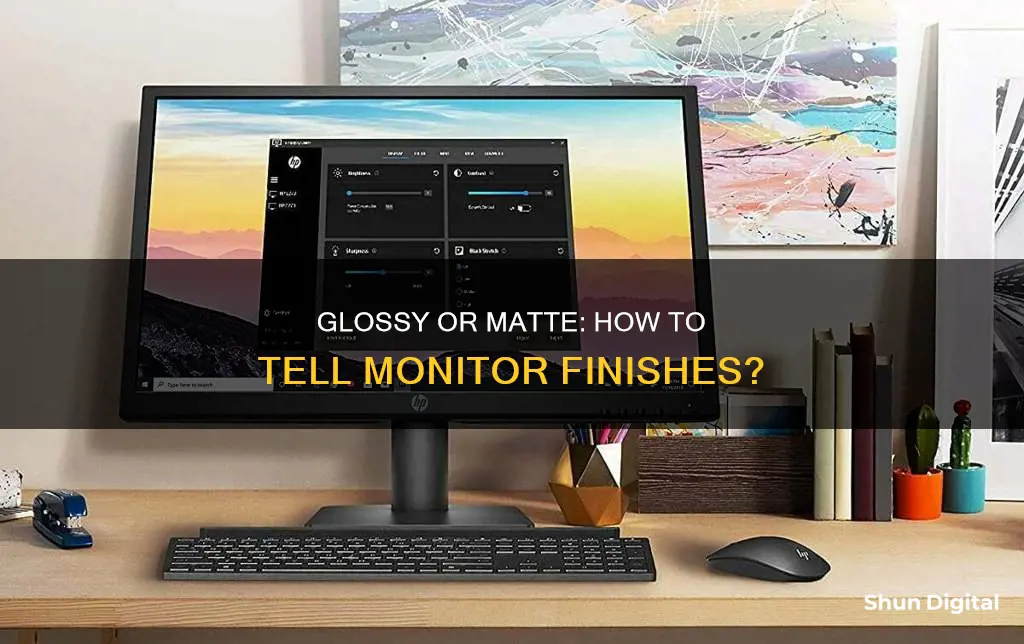
Choosing between a matte and a glossy screen can be tricky, but it ultimately comes down to your specific needs, environment, and personal preferences. Both types of screens have their unique advantages and drawbacks, catering to different lifestyles and work environments. Matte screens are designed to reduce glare and reflections, making them ideal for bright environments and tasks that require prolonged screen time. On the other hand, glossy screens are known for producing vibrant colours and high contrast levels, making them a favourite among media consumers and professionals who need accurate colour representation.
| Characteristics | Values |
|---|---|
| Image Quality | Glossy screens showcase deeper darks, brighter whites, and richer colours than matte screens. Matte screens may cause some minor details to be diminished and colours to be less vibrant. |
| Lighting | Glossy screens reflect light, which can reduce visibility in bright environments. Matte screens are better suited for bright environments as they reduce glare and reflections. |
| Reflections | Glossy screens are highly reflective and can cause glare. Matte screens are less reflective and reduce glare. |
| Eye Strain | Glossy screens can cause eye strain due to glare and reflections. Matte screens are designed to reduce eye strain as they scatter light in all directions, reducing the amount of glare that enters the eye. |
| Ease of Cleaning | Glossy screens are easier to clean than matte screens. Matte screens are made of softer plastic polymers and coatings that can be more difficult to clean. |
| Fingerprints | Glossy screens are more prone to fingerprints and smudges. Matte screens are less prone to fingerprints. |
| Dust | Glossy screens are more susceptible to dust buildup. |
| Usage | Matte screens are ideal for tasks requiring prolonged screen time, such as working or browsing the internet. Glossy screens are ideal for movies and gaming due to their immersive experience. |
| Professions | Matte screens are preferred by programmers and writers, while glossy screens are often preferred by designers and photo editors. |
What You'll Learn

Matte screens are less reflective and can reduce eye strain
Matte screens are less reflective than glossy screens and can reduce eye strain. This is because matte screens are made of plastic and undergo an etching process, either chemical or mechanical, which creates a large number of grooves or indentations in the screen surface. This process scatters light that hits the monitor, reducing reflectivity. While some glare may still occur, it will not be as intense as the reflections on a glossy display.
Glossy screens, on the other hand, use reflective glass or polymers, which allow almost all of the display's light output to show through, resulting in a very vivid image. However, this also means that light sources in the environment will be reflected onto the screen, causing glare and eye strain.
To reduce eye strain, it is recommended to eliminate glare by ensuring that no light sources, such as windows, are directly behind or in front of your screen. If glare is still an issue, an anti-glare filter can be used. Additionally, following the 20/20/20 rule can help reduce eye strain. This involves looking at least 20 feet away from your screen for 20 seconds every 20 minutes.
Matte screens are also easier to maintain than glossy screens, as dust and fingerprints are less visible on matte surfaces.
Overall, while matte screens may not look as good as glossy screens in a highly controlled environment, they are a more practical and comfortable option for everyday use.
Connecting a Chromebox to a Monitor: A Step-by-Step Guide
You may want to see also

Glossy screens are more vibrant but reflect light
Glossy screens have a reflective layer that enhances colour visibility and contrast, resulting in a more immersive viewing experience. This makes them ideal for watching movies and gaming. They are also preferred by designers and photo editors, as they can show a wider range of colours and have better contrast ratios. However, the trade-off is that the reflective surface of glossy screens can cause issues in bright environments, reducing visibility and making it difficult to view the content on the screen.
Glossy screens are typically made of either glass or a reflective polymer, similar to the surface of a flagship smartphone. They provide a more consistent and clear image than matte displays. The majority of people and companies seem to prefer the texture of glossy displays, which is why Apple no longer offers a matte MacBook Pro option.
The high degree of transparency in glossy screens allows almost all of the display's light output to show through, resulting in a very vivid image. Glossy screens showcase deeper blacks, brighter whites, and richer colours than their matte counterparts. However, they are more prone to fingerprints and smudges, which can be distracting and affect the viewing experience.
Glossy screens can be kept clean more easily than matte screens. While they may pick up fingerprints more easily, the hardened nature of their surface means that it is easy to clean their glass surface and wipe away fingerprints or dust without problems.
In dimly lit spaces, glossy screens can enhance the perceived brightness of the screen, making them easier to view in low-light conditions. However, it is important to adjust the screen's brightness and contrast to optimise the viewing experience.
Matte screens, on the other hand, are designed to reduce glare and reflections with an anti-glare coating that scatters light. This makes them ideal for use in bright environments, especially outdoors, and in areas with multiple light sources. They are also less prone to fingerprints and smudges, which can be beneficial in shared or professional workspaces.
Matte screens employ plastic surfaces made of different polymers that undergo an etching process, which creates grooves or indentations in the screen surface to reduce reflectivity. While some minor glare may still occur, it never comes close to the full-on reflections of glossy displays.
Matte screens are less reflective than glossy screens, making them a more balanced option for daily use. They are ideal for tasks that require prolonged screen time, such as working or browsing the internet. The reduced glare and reflections also make it easier to focus on the content, making them a preferred choice for programmers and writers.
However, the anti-glare coating on matte screens can soften colours and reduce contrast, resulting in a less vibrant viewing experience. Additionally, the light-diffusing properties of matte screens can cause high-resolution display panels to lose clarity.
Monitoring Internet Usage on iPads: A Comprehensive Guide
You may want to see also

Matte screens are ideal for outdoor use
Matte screens have an anti-glare coating that scatters light, minimising reflections and reducing the amount of glare that enters the eye. This feature is particularly useful in bright outdoor environments, as it helps to improve visibility and reduce eye strain. In comparison, glossy screens reflect light, which can reduce visibility and cause eye fatigue, dryness, and irritation.
The matte finish also helps to mask fingerprints, keeping the screen cleaner for longer. This is advantageous for outdoor use, where dirt and oil from fingers can be more prominent. Additionally, matte screens tend to be less distracting, allowing users to focus on the content rather than the screen itself.
While matte screens may affect the visual quality of the display, with colours appearing softer and contrast reduced, the trade-off is often worth it for those who value usability over visual quality. Matte screens also continue to improve in terms of image quality, with modern monitors increasing in brightness, so the difference in visual experience may not be noticeable in most cases.
Overall, matte screens are a sensible choice for outdoor use, providing a more comfortable and practical viewing experience.
Asus Monitor Release Schedule: How Often Do They Launch?
You may want to see also

Glossy screens are more cinematic and suited to gaming
Glossy screens are ideal for those seeking a cinematic experience or immersive gaming. Their reflective display enhances colours, contrast, and overall visual quality, making the viewing experience more engaging and lifelike. This is particularly important for gamers who want to be fully immersed in their virtual environment. The glossy finish also helps to reduce glare from ambient light, allowing for a more focused viewing experience.
Glossy screens are known for their vibrant colours and high contrast levels, making them a favourite among those who consume a lot of media. This is because they have a reflective layer that enhances the visibility of colours and contrast, resulting in a more immersive viewing experience. The reflective display enhances the vibrancy of colours, making it easier to distinguish between subtle shades. This is crucial for professionals such as designers and photo editors, who need to accurately represent their work.
Glossy screens showcase deeper darks, brighter whites, and richer colours than matte screens. Their high degree of transparency allows almost all of the display's light output to show through, resulting in a very vivid image. However, they do so at a cost. The downside of glossy screen beauty stems from reflectivity. In bright environments, glossy screens can reflect light, reducing visibility and making it difficult to view the content on the screen. This can be problematic for those who work or watch media in well-lit areas.
Glossy screens are more prone to fingerprints and smudges, which can be distracting and affect the viewing experience. Dust also tends to stick to glossy screens, so they require considerable maintenance to keep clean. However, if you can control the lighting in your environment and ensure that no light sources reflect onto the screen, then glossy screens offer superior image quality.
Destroying an LCD Monitor: Step-by-Step Guide
You may want to see also

Matte screens are the professional standard
Secondly, matte screens offer a more balanced viewing experience, making them suitable for tasks that require prolonged screen time, such as working or browsing the internet. The reduced glare and reflections allow the viewer to focus on the content rather than the screen itself, making matte screens less distracting and more comfortable to use over extended periods.
Thirdly, matte screens are more versatile and perform better in bright environments and outdoor settings. They are less reflective and can handle sunlight better, making them a practical choice for individuals who work outdoors or spend a lot of time in natural light.
While matte screens may affect visual quality by softening colours and reducing contrast, this trade-off is often worth it for those who value usability and eye comfort over a vibrant viewing experience. Additionally, modern monitors continue to increase in brightness, and with improvements in matte coatings, image quality on matte screens continues to improve.
Therefore, matte screens are the preferred choice in professional workspaces due to their ability to reduce glare and reflections, minimise eye strain, and provide a balanced and comfortable viewing experience, especially in well-lit environments.
Connecting Ancient Monitors to 1080 FTW: A Comprehensive Guide
You may want to see also
Frequently asked questions
The easiest way to identify if a monitor is glossy or matte is by looking at the model series. Most monitors are matte, but if you're looking for a glossy screen, you can identify it by the model series.
Glossy screens are often preferred by designers and photo editors as they can display a wider range of colours and have better contrast ratios. The reflective display also enhances the vibrancy of colours, making it easier to distinguish between subtle shades.
Yes, matte screens are generally considered better for eye health as they reduce glare and reflections, which can contribute to eye strain over time. However, some users may find that the anti-glare coating on matte screens softens the colours and reduces the contrast, resulting in a less vibrant viewing experience.







